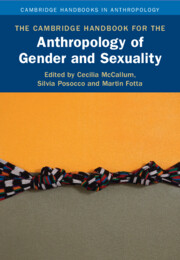Book contents
- The Cambridge Handbook for the Anthropology of Gender and Sexuality
- Cambridge Handbooks in Anthropology
- The Cambridge Handbook for the Anthropology of Gender and Sexuality
- Copyright page
- Contents
- Contributors
- 1 Introduction to The Cambridge Handbook for the Anthropology of Gender and Sexuality
- Part One Openings and Orientations
- Part Two Knowledges and Domains
- 6 Gender, Sociality, and the Person
- 7 The Postmodern Moment in Gender Studies and Anthropology
- 8 Gender(ed) Language and the Linguistics of Sexuality
- 9 Conceptualizing Bodies, Hierarchy, and Gendering across Cultures
- 10 Language, Gender and Sexuality, and Performativity
- 11 Anthropological Engagements with Men and Masculinities
- Part Three Resistances and Intersections
- Part Four Desires and Relations
- Part Five Recursivities and Futures
- Name Index
- Subject Index
- References
8 - Gender(ed) Language and the Linguistics of Sexuality
from Part Two - Knowledges and Domains
Published online by Cambridge University Press: 29 September 2023
- The Cambridge Handbook for the Anthropology of Gender and Sexuality
- Cambridge Handbooks in Anthropology
- The Cambridge Handbook for the Anthropology of Gender and Sexuality
- Copyright page
- Contents
- Contributors
- 1 Introduction to The Cambridge Handbook for the Anthropology of Gender and Sexuality
- Part One Openings and Orientations
- Part Two Knowledges and Domains
- 6 Gender, Sociality, and the Person
- 7 The Postmodern Moment in Gender Studies and Anthropology
- 8 Gender(ed) Language and the Linguistics of Sexuality
- 9 Conceptualizing Bodies, Hierarchy, and Gendering across Cultures
- 10 Language, Gender and Sexuality, and Performativity
- 11 Anthropological Engagements with Men and Masculinities
- Part Three Resistances and Intersections
- Part Four Desires and Relations
- Part Five Recursivities and Futures
- Name Index
- Subject Index
- References
Summary
The first part of this chapter provides a brief overview of the developments in the study of language, gender, and sexuality, with a focus on anthropological works and leading ethnographies, while the second part focuses on a particular case study from South Africa. It aims to capture examples of the multiple, flexible, and fluid ways in which linguistic, gender, and sexual identities are entangled and how they are negotiated in relation to power. The case study focuses on Zulu speakers, South Africa’s largest ethnolinguistic group. Ethnographic detail from the province of KwaZulu-Natal provides a nuanced discussion of how gendered and sexual Zulu identities are represented through three selected linguistic styles and how despite important differences in the Zulu ways of speaking and being, there are also remarkable commonalities that expose a matrix of oppression based on patriarchy, sexual and gender(ed) “otherness,” as well as pervasive heteronormativity and racism. The study demonstrates that African spaces provide a multitude of linguistic resources to recalibrate previous thinking around language, gender, and sexualities by theorizing with a “southern” lens.
- Type
- Chapter
- Information
- Publisher: Cambridge University PressPrint publication year: 2023



